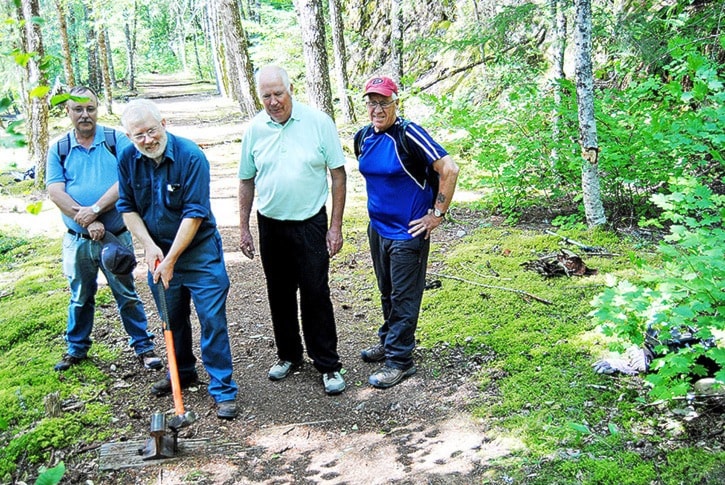A group of rail history and outdoors enthusiasts marked an important 100th anniversary July 31, with a commemorative “last spike” ceremony.
July 31, 1916 was the day the Coquihalla line of the Kettle Valley Railway opened for traffic. The construction and opening of the railway was the final step in a lengthy political and economic campaign to link the Okanagan, Boundary and Kootenay areas of British Columbia with the coast by rail.
The campaign also sought to prevent American railroads from reaping most of the profits from the mines, smelters, forests and farms of the southern interior.
Sunday’s ceremony took place along the former KVR grade above Highway 5 near the Ladner Creek trestle, one of the few remaining structures from the Coquihalla line that is still standing. The initial event marking the completion of the railway took place near the trestle in July 1916.
An earlier commemoration of the 100th anniversary of the Coquihalla line took place at Othello Tunnels in Coquihalla Canyon Provincial Park near Hope in June, with a walking tour conducted by historian, author and former KVR employee Joe Smuin of Chilliwack.
He and KVR historian Barrie Sanford, the author of McCulloch’s Wonder, the 1977 book that was the first definitive history of the KVR, both took part in Sunday’s event.
“The Coquihalla line was something special in every respect,” Smuin said. “It’s really what gave the KVR its reputation.”
“One hundred years ago today, the first regular passenger train went through Coquihalla Pass,” Smuin noted at the ceremony on Sunday. “We are not sure of the exact date of the last spike ceremony. A special train did go through the pass on July 30 and likely it stopped here and had a ceremony at that time.”
Sanford’s book focused on the unparalleled engineering abilities of Andrew McCulloch, who located the line and was responsible for its construction.
He showed a tie clip given to McCulloch by Canadian Pacific Railway president Thomas Shaughnessy in 1916, when the two were aboard a special train that rode over the Coquihalla line in September 1916. CPR supplied the capital for the construction of the KVR, which remained nominally independent until operations were taken over by the parent railway in 1931.
It was also McCulloch who decided to build the Othello tunnels, also known as the Quintette tunnels, along the lower portion of the Coquihalla River. He also named all the stations along the Coquihalla line, giving them names from various Shakespeare plays. Among the Shakespearean names were Othello, Lear, Jessica, Portia, Iago, Romeo and Juliet. Those names attracted much attention to the line after it was built.
Although the political battles which led to the eventual construction of the KVR between Midway and Hope were front page news for many years, and building the railway was a key issue in several provincial elections in the early 1900s, the opening of the Coquihalla line barely rated a mention in 1916. This was largely because it occurred in the midst of the First World War.
The Somme offensive, which lasted until November and led to the deaths of more than 300,000 soldiers, had started on July 1. The newspapers of the day (the only media outlets of the era) had many other things to report.
The Coquihalla Pass rail line had a short and turbulent history. It was racked by high operating costs due to washouts, snowslides, rock falls and the difficulties of dealing with rapidly-changing weather. It was frequently closed for lengthy periods during the winters, with rail traffic then using an alternative line through Merritt to Spences Bridge on the CPR mainline.
Much of the Coquihalla line was built on steep hillsides above the river, because of the necessity to keep the rail line to a maximum 2.2 per cent grade. It had numerous snow sheds and tunnels, most built through unstable rock. Most of the construction and much of the maintenance work was done by hand in the early years.
After a series of washouts in November 1959, the rail line through the Coquihalla was abandoned by the CPR and the tracks were torn up in 1961 and 1962. It was the first major abandonments of a portion of the KVR.
The final portion of the railway, between Okanagan Falls and Spences Bridge, was abandoned in 1989. Much of that rail grade is now in use as a portion of the Trans-Canada Trail.
The direct route offered by the rail line through the Coquihalla attracted interest from transportation planners, and the provincial government under Premier Bill Bennett eventually decided to build a new toll highway through Coquihalla Pass.
Much of it follows the original KVR route, with a portion built on or adjacent to the KVR grade. The highway opened in 1986, and tolling came to an end in 2008.
